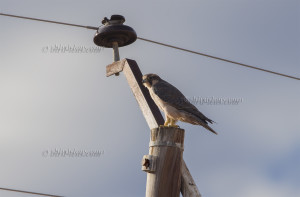 Lanner Falcon (Falco biarmicus) is a highly thought-after species for a central European birdwatcher. Lanner Falcons are the large Falcon in the Mediterranean region and in Africa. This Falcon is replaced by the Saker Falcon (Falco cherrug), a raptor widely distributed in warm-temperate zones from southeast Europe (mainly Hungary) and Turkey to the Central Asiatic steppes. The five species of large falcons (Falco sp.) which occur in the western Palearctic constitute one of the most impressive and exciting groups of birds in Europe. They have long attracted great interest and attention among ornithologists and non-birdwatchers alike.
Lanner Falcon (Falco biarmicus) is a highly thought-after species for a central European birdwatcher. Lanner Falcons are the large Falcon in the Mediterranean region and in Africa. This Falcon is replaced by the Saker Falcon (Falco cherrug), a raptor widely distributed in warm-temperate zones from southeast Europe (mainly Hungary) and Turkey to the Central Asiatic steppes. The five species of large falcons (Falco sp.) which occur in the western Palearctic constitute one of the most impressive and exciting groups of birds in Europe. They have long attracted great interest and attention among ornithologists and non-birdwatchers alike.
The Lanner Falcon (Falco biarmicus) breeds in western Palearctic from its northern limit in Italy with 100-140 pairs over Greece with 36-55 pairs, Turkey with 300-600 pairs to Armenia with 20-30 pairs. In the east the trend is unknown but the general perception is declining. There are 3 subspecies in the West Palearctic, with feldeggii breeding in Italy, the Balkans and Asia Minor, tanypterus in the Middle East and west to Libya, and erlangeri in northwest Africa. All three races typically inhabit dry areas, especially semi-desert and desert in the east and south. Lanner Falcon is a sedentary species, but with a few individuals (juveniles) migrating during dispersal from their parents home territory. As the Saker Falcon, Lanner Falcon seem to move to winter quarters in arid parts of the Middle East.
There are only a few records from the northern part of Europe or Great Britain (as North Wingfield – Derbys – in October 2014, Mottisfont – Hants – in March 2014 or from Edinburgh in April 2013. The Lanner Falcon is a bird of open country and savanna which is divided in five subspecies (biarmicus, abyssinicus, erlangeri, feldeggii and tanypterus), spread across the Western Palearctic, Arabian Peninsula, and central and southern Africa. Lanner Falcons are widespread and generally common in Africa, even in populated areas. Thus, it might be an idea to visit the Republic of South Africa (RSA) if you do not mind to observe the subspecies F. b. biarmicus which occurs from Angola and southern Kenya down to South Africa. Lanner Falcons might be confused – mainly in immature plumages – with Saker Falcons. Lanner are quite large in size and similar Saker Falcons in general proportions. When perched, Lanner Falcons look more slender-bodied and smallerheaded than Saker. Seeing the bird sitting on a pylon it really looked like a Eurasian Kestrel (Falco tinnunculus). An impression you will not have with a Peregrine Falcon. Of the five species occurring in the West Palearctic, the most familiar to most people is the Peregrine Falcon (Falco peregrinus): this is a cosmopolitan species which is widespread in the region, being rare to locally common, and resident, dispersive or migratory, the most migratory race (calidus of the northern tundra) wintering as far south as South Africa; it is found in a wide range of usually open habitats, from arctic/alpine to semi-desert. The Gyrfalcon (Falco rusticolus), by contrast, is a rare breeder, largely confined to the arctic and subarctic belt, where it is mainly resident to partially migratory, rarely extending farther south than 60°N in winter, and occurring as a vagrant in western Europe south to Portugal and Italy; it inhabits open terrain, such as tundra, barren uplands or rocky coasts, often in partly wooded areas. The Saker Falcon (Falco cherrug) is rather widely distributed, but uncommon and generally declining, in warm-temperate zones from the Central Asiatic steppes west to southeast Europe (mainly Hungary) and Turkey; it also winters regularly in arid parts of the Middle East, with a few records from the rest of Europe. Barbary Falcons (Falco pelegrinoides) are largely confined to the deserts of North Africa and the Middle East but occurs on Canary Islands as well. This falcon is mostly resident. Not only Lanner Falcon (Falco biarmicus) present some identification challenges. An very good paper on large Falcons describes all plumages likely to be met with in this region, including geographical and age-related variations, and discusses the problems involved and the best ways of approaching these. Structure, silhouette and flight behaviour are important factors, and detailed examination of plumage is usually also a prerequisite for correct identification of these raptors. To cope with the growing demand for top shots of the rarer species of the Palearctic Bird-Lens.com is keen to enrich the range of pictures of birds you can find in the western palearctic. Trips to productive locations in Germany but also to remote places in the world to capture images of rare birds of western palearctic were very successful. The nice image of the blog was shot in the Namaqualand of the Republic of South Africa near the town of Springbok and is only a first impression, what you will find in the gallery in the “Picture Shop” very soon. Just give a message, if bird-lens.com could serve you with an image needed before the new pictures are online.